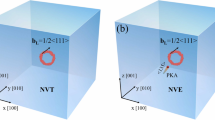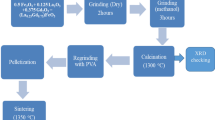Abstract
Radiation defects arising from the high-dose implantation of 57Fe+ ions into matrices of refractory Mo and Ta metals are studied by Extended X-ray Absorption Fine Structure (EXAFS) spectroscopy in the region of the Fe K-edge Fe. The concentration of Fe atoms, which is calculated using the SRIM program, is 2.5 at % at a depth of ≈300 nm. The concentration of radiation-induced defects exceeds 100 dpa. The positions of Fe atoms are determined in the samples after implantation and additional annealing at 700°C. In Mo, Fe atoms are predominantly located in substitution positions in a body-centered cubic (bcc) crystal lattice. An analysis of the EXAFS spectra shows that, on average, 1.4 atomic vacancies are in the first coordination sphere of Fe, which corresponds to a vacancy concentration of about 24 at %. In the Ta matrix, Fe atoms are located in a more complex manner. To analyze the data, model EXAFS spectra are calculated for typical atomic configurations of Fe atoms in a Ta matrix, which form as a result of irradiation. Relaxation of the crystal environment of Fe atoms is taken into account by the density-functional-theory method. Comparison of the experimental spectra with the calculated ones shows that Fe atoms are located in several positions in Ta, including interstitial and substitution positions. Annealing leads to a change in the coordination and partial segregation of Fe atoms. The EXAFS data are consistent with previously published Mössbauer-spectroscopy data. It is demonstrated that the EXAFS method makes it possible to more accurately determine the configurations of defects arising from irradiation.





Similar content being viewed by others
REFERENCES
G. S. Was, Fundamentals of Radiation Materials Science: Metals and Alloys (Springer, New York, 2007; Teknosfera, Moscow, 2014).
SRIM. http://www.srim.org/.
V. A. Andrianov, K. A. Bedelbekova, A. N. Ozernoy, M. F. Vereshchak, and I. A. Manakova, Nucl. Instrum. Methods Phys. Res., Sect. B 475, 71 (2020). https://doi.org/10.1016/j.nimb.2020.04.035
A. A. Chernyshov, A. A. Veligzhanin, and Y. V. Zubavichus, Nucl. Instrum. Methods Phys. Res. A 603, 95 (2009). https://doi.org/10.1016/j.nima.2008.12.167
M. E. Downey and B. L. Eyre, Philos. Mag. 11 (109), 53 (1965). https://doi.org/10.1080/14786436508211924
G. V. Fetisov, Synchrotron Radiation: Methods for Studying the Structure of Substances, Ed. by L. A. Aslanov (Fizmatlit, Moscow, 2007) [in Russian].
K. Nordlund, St. J. Zinkle, A. E. Sand, F. Granberg, R. S. Averback, R. E. Stoller, T. Suzudo, L. Malerba, F. Banhart, W. J. Weber, F. Willaime, S. L. Dudarev, and D. Simeone, J. Nucl. Mater. 512, 450 (2018). https://doi.org/10.1016/j.jnucmat.2018.10.027
W.-Li. Yan, H.-Bo. Zhou, Sh. Jin, Y. Zhang, and G.‑H. Lu, J. Nucl. Mater. 456, 260 (2015). https://doi.org/10.1016/j.jnucmat.2014.09.045
P. Giannozzi, S. Baroni, and N. Bonini, J. Phys.: Condens. Matter 21, 395502 (2009). https://doi.org/10.1088/0953-8984/21/39/395502
R. Fletcher, Practical Methods of Optimization, 2nd ed.(Wiley, New York, 2017).
Y. Joly, Phys. Rev. B 63, 125120 (2001). https://doi.org/10.1103/PhysRevB.63.125120
K. J. Yang, Y.-L. Liu, Zh.-Li. Liu, Q. Yao, P. Shao, X. Zhang, Q.-F. Han, and Y. Ma, J. Nucl. Mater. 527, 151805 (2019). https://doi.org/10.1016/j.jnucmat.2019.151805
ACKNOWLEDGMENTS
The work was performed within the research programs of the Skobeltsyn Institute of Nuclear Physics, Moscow State University, the National Research Center “Kurchatov Institute”, and the Institute of Nuclear Physics of the Republic of Kazakhstan. Theoretical calculations were carried out using the computing facilities of the National Research Center “Kurchatov Institute” (http://computing.nrcki.ru).
Author information
Authors and Affiliations
Corresponding author
Ethics declarations
The author declares that he has no conflicts of interest.
Additional information
Translated by L. Chernikova
Rights and permissions
About this article
Cite this article
Andrianov, V.A., Bedelbekova, K.A., Erzinkyan, A.L. et al. EXAFS Study of Radiation-Induced Defects in Molybdenum and Tantalum Metals. J. Surf. Investig. 16, 441–447 (2022). https://doi.org/10.1134/S1027451022040024
Received:
Revised:
Accepted:
Published:
Issue Date:
DOI: https://doi.org/10.1134/S1027451022040024




